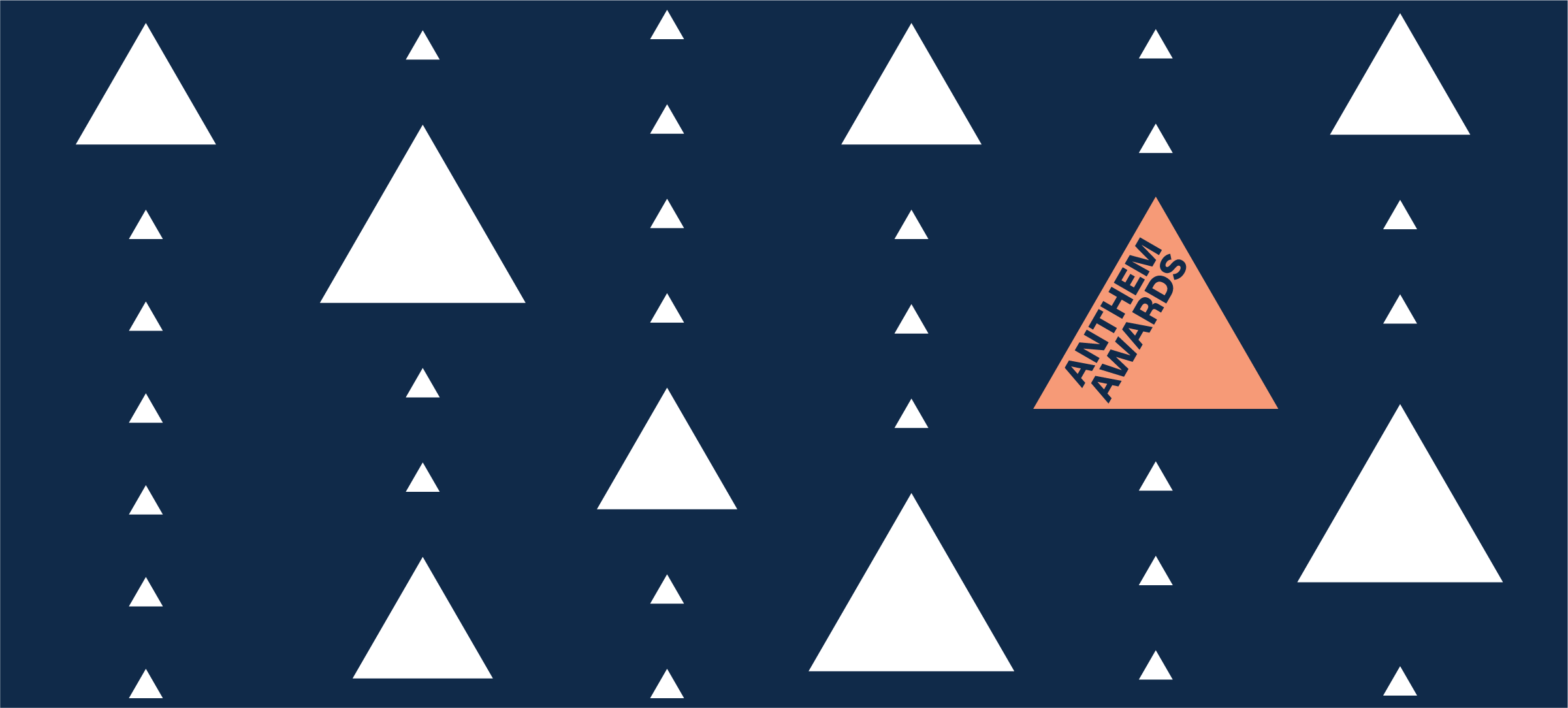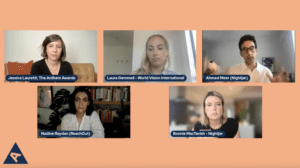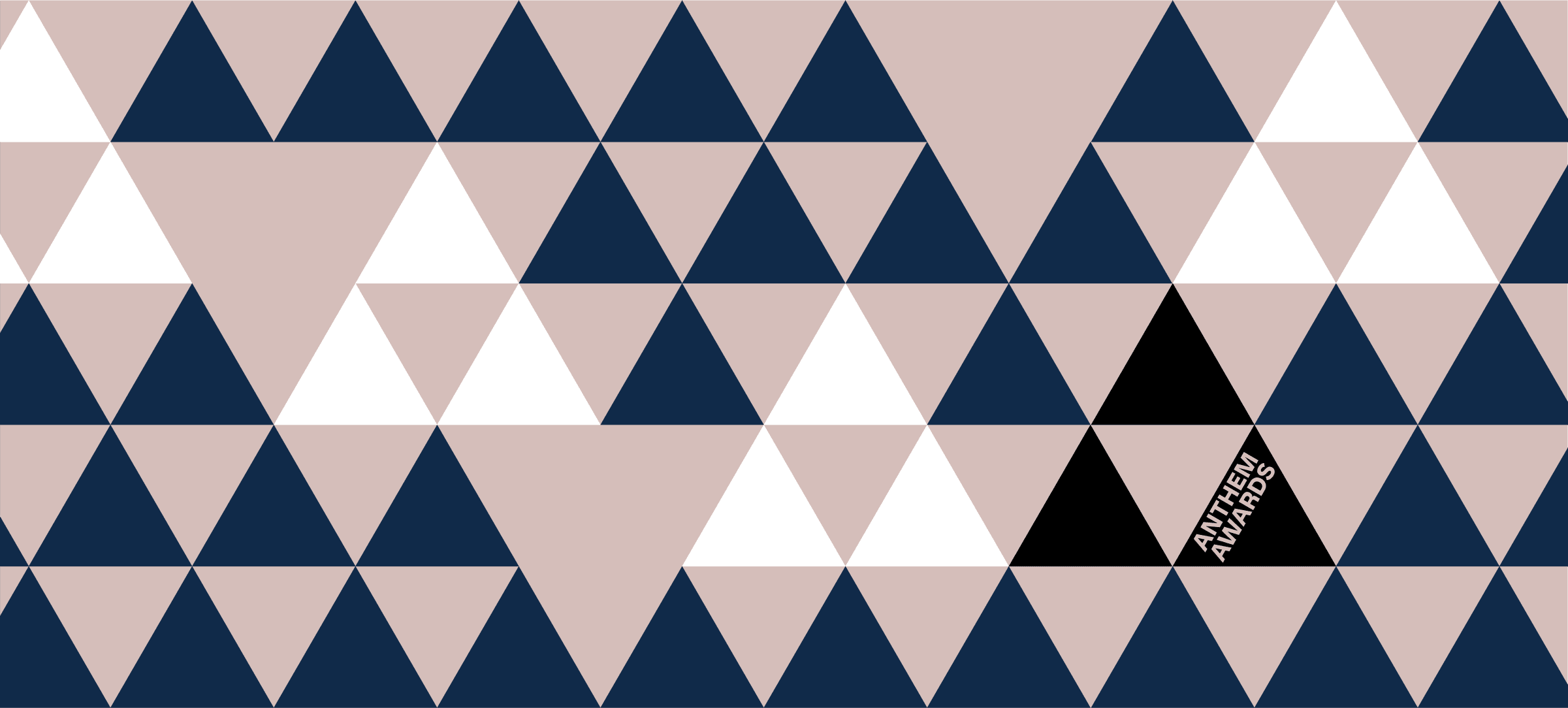Impact Stories: Global Voices
Featuring:
Bonnie McTavish, Head of Experience Strategy at Nightjar, and Ahmed Meer, Head of Design Technology at Nightjar, Nadine Raydan, Senior Project Manager at ReachOut, and Laura Gemmell, Director of Global Public Engagement at World Vision International.
Moderated by: Jessica Lauretti, Managing Director of the Anthem Awards


Impact Stories: Global Voices
As part of the Inaugural Anthem Awards Conference on February 28, 2022, leaders from organizations like Nightjar, World Vision International and ReachOut came together to discuss their mission-driven projects.
Highlights include:
- Bonnie McTavish reports 55% of users stated the support was helpful and useful.
- Ahmed Meer of Nightjar reveals how NextStep acts as a funnel to help users feel and process their emotions fully, allowing them to understand what they are experiencing so the app can encourage them to take the NextStep in the right direction.
- Laura Gemmell gives all the details as to how the non-profit was able to create their award-winning project through strategic sourcing
Watch the full discussion:
Read the full transcript below:
Jessica Lauretti 00:17
Hi everyone, I’m Jessica Lauretti, the Managing Director of the Anthem Awards. Thank you for joining us for our final session of the day. We have two amazing projects from two of our previous sessions, but folks from the other side of the world, so we have four people coming to you from the future. It is Tuesday A.M. in Australia in New Zealand, but we really wanted to give these folks an opportunity to share their amazing projects with you all. So just quickly introduce who we have on our panel here today. We have Bonnie McTavish, Head of Experience Strategy at Nightjar, Ahmed Meer, Head of Design Technology at Nightjar and Nadine Raydan from ReachOut, they’re going to be presenting on their project NextStep. We have Laura Gemmell Director of Global Public Engagement at World Vision International to talk about their work with refugees. So, in this first part of this session, we’re going to give each group an opportunity to share the case study of their project. First up, we’re going to hear from Bonnie McTavish, Ahmed Meer and Nadine Raydan for their project NextStep.
Bonnie McTavish 01:37
Thank you so much, Jess, and thank you for the lovely introduction. Good morning or good afternoon to everybody out there. Nightjar is an Experience Design company based in Sydney, Australia. We marry meticulous, yet emotive design with tomorrow’s technology for brands both big and blossoming. By far the most rewarding is that and the most challenging as well is the work that we do with our not for profit partners. That takes us to ReachOut. ReachOut is Australia’s most visited online mental health resource, with the website providing invaluable support, specifically for young people aged 14 to 25. Helping with everything from everyday questions all the way through to really tough times. So ReachOut reached out to Nightjar for help on one of their digital tools, which is called NextStep, which you can see on the screen here. What NextStep is is a self triage system where young people can select symptoms that they may be experiencing and then form an initial diagnosis of their mental health. However, the problem was that young people don’t always know how to articulate what is wrong with them. The existing NextStep tool was very clunky and faced users with a huge list of 100 Overwhelming symptoms when they launched the tool. So, our vision along with ReachOut was to create a personalized experience, which would help young people understand their individual situation and give them the tools to take control of their mental health. So what was our solution? First of all, we reduced the number of steps to diagnose an issue to make sure we were decreasing drop off. Second, we created 15 overarching categories for the 100 symptoms so the experience wasn’t so confronting when you first launched the tool. Now this may sound simple enough, but its shifting classification is overseen by an independent clinical advisory board, because ReachOut deals with mental health. Rightfully, they have very strict protocols in place that we need to respect on every step of the journey. Number three, we integrated NextStep into a more friendly chatbot style interaction with plenty of emojis. However, emojis are very subjective. So, we had to embark upon rigorous user testing to land on our final selection of emojis. I never really thought that in my career, I would spend so long debating the hidden side of grinning or hugging face or stuck out tongue and winking eye. Number four, we ensure the tool is available at multiple points on the ReachOut parent website so it is easily accessible. Last of all, we created a simple mental health plan that users could return to, even without creating a login with different support services and resources that they could try. Good UX can literally be life saving and our results post launch, including a 35% increase in users getting personalized recommendations, and 55% of young people expressing that the support options that they received were helpful, makes us feel incredibly thankful to be making an impact.
Jessica Lauretti 04:41
Thank you so much for sharing. Next up we’ll have Laura Gemmell, Director of Global Public Engagement at World Vision International to share their project refugee phone takeover.
Laura Gemmell 04:53
Thanks so much, Jess. Thanks for having me. As World Vision works in almost 100 countries around the globe and We implement long term sustainable development initiatives and provide humanitarian aid. Our focus is always on children, protecting them, providing them with opportunities to learn and advocating for their rights. As Director of Public Engagement partnerships, it was my job to ensure children’s voices were heard. I did that by partnering with organizations that were skilled at innovative storytelling and or had distribution platforms that hit our target audiences. So for World Refugee Day last year, World Vision, partnered with #OurStories, and we received a gold award for our highly effective and low cost, refugee phone takeover video, which is what I’ve been asked to talk about today. We really wanted to create a sense of connection and understanding between our target audience, which is older millennials with children, and families forced to flee their homes. We also wanted to highlight a crisis that was underreported, which led us to Democratic Republic of Congo, a place where I guess the majority of people would have, you know, some difficulty locating on the map. So we sort of set ourselves a heck of a challenge. We knew we had to create something immersive, where the viewer finds themselves in a refugee’s shoes, and experiences some of the instantaneous life changing, impossible choices, and all honestly families have to face when they’re in conflict zones. You know, do you risk waiting for your husband to come home from work? Or do you flee with the children now? You know, what do you pack when you have no idea where you’ll be going and how long you’ll be going for? You know, what do you do with the family pets? You know, all things that we’re seeing play out in Ukraine right now, as well. So ultimately, with the crew at #OurStories, we created a video that chronicled one family’s story through a mobile phone interface. We chose this because most of us live on our phones these days, like it or not, and it created a sense of familiarity. We replicated certain mobile phone apps and features to enhance our storytelling, including screensavers, WhatsApp voice notes, Google Maps, the camera function, Twitter notifications, and even Facebook’s mark-yourself-safe function. The video ends with a notification announcing our main characters have arrived in Uganda, before the phone battery dies.
Jessica Lauretti 07:33
Great, thank you so much. I have a couple questions so we can bring everyone back up. So for the ReachOut / Nightjar team first, can you talk a little bit about feeling *inaudible noises* and then coupling that with creating access to a range of tools for a range of problems is helping to end the stigma around getting help for mental health issues.
Nadine Raydan 08:05
I’ll take this on Jessica. Hello, everyone. It’s really wonderful to be joining you from the Gadigal Land of Eora Nation. I extend that respect to any First Nation people attending here today. So thank you for having us and for the recognition. I think just taking a step back as a Product Manager, I want to acknowledge very upfront that National research shows that some groups so if you belong to the LGBTQIA plus communities, or if your Aboriginal and Torres Strait Islander young person, or if you live in regional, rural or remote locations, and hopefully one day we’ll find a better way to classify this group. If you’re culturally or linguistically diverse, you’re overrepresented in the mental health data. So we’ve also seen an increase in psychological distress amongst 18 to 24 year olds over the years. To contextualize things not all young people coming to ReachOut any of our services because we work with young people’s schools and parents are in equal or high distress, some young people often revisit the service and really different head spaces, so they can be feeling low, moderately distressed one day, but in super high distress and other and knowing this really allows us to design for, like all young people to feel better. One of the core principles behind all of our services as products is to create a safe place for them to incrementally do that in a really self directed and authentic way. So NextStep came to life conceptually after listening to young people tell us that there was too much choice and not enough navigational support, especially through which services were right for them, based on what they’re experiencing at the time, how tough it was on them or where they were living. It’s been specifically designed to reduce that burden of choice and what we’re seeing in terms of crowded marketplaces, choice overload. It really doesn’t just exist in streaming and social media platforms or dating apps, but it affects the mental sector too and in the space that can lead to young people feeling overwhelmed. So definitely not being flippant and comparing the two, but rather saying it’s really critical that young people find a way to navigate this space. So when a young person isn’t sure of what they’re experiencing, or what service modality or type of service is right for them at the time, that could be phone face to face, online chat, online forums or information, it’s difficult to know where to start when they’re overwhelmed in some cases that can lead them to stop searching. So, when we redesign NextStep to approximate this experience of a conversational agent, as Bonnie was mentioning earlier, the language UI and UX were of equal importance, young people really need that familiarity of the platform coupled with a visual identity that doesn’t deter them from appearing intergenerational. It needs language that resonates that sounds like them and, NextStep is most importantly, co-designed. So all iterations, including this one, are tested again, with different cohorts of young people. That’s how we know emojis still resonate. For example, to your question, the part of your question on feeling a really important part of helping young people identify what they’re going through is to show them a range of common experiences. That framed here is issues or symptoms. But really, the next step is to encourage them to select what they relate to. Just seeing how they feel put into words can be disarming. So, helping young people know that they’re not alone, and that other people are feeling and experiencing similar things is an important step in destigmatizing mental health issues. It’s important to note that presenting all the service options and pairing those to specific issues or symptoms, as well as the severity level, and the location, makes taking the next step a little less vulnerable, because it communicates that how they’re feeling warrants that engagement with a number of support options. Unfortunately, we still hear many young people often question whether their problems and feelings are big enough to warrant support. The stigma around mental health makes so many of them question whether they’re worthy of support. So, we know that 70% of young women and 80% of young men who need help and support don’t get it. By clearly linking their experience, to support options. NextStep helps reduce that fear that the experience isn’t worthy of support and encourages young people to take the next step in improving their mental health. With one in four young people in Australia currently experiencing a mental health difficulty, it’s really important that we continue to support young people as they navigate through what can present as a really difficult time. By helping them move from a phase of trying to understand to taking action for the next step, instill that sense of hope, and urgency.
Jessica Lauretti 12:50
Wonderful, thanks for sharing that. Bonnie and Ahmed, can you talk a little bit from the perspective of human centered design or designed for good, or how good UX, good design can be literally life saving for people?
Bonnie McTavish 13:04
After you. Ahmed,
Ahmed Meer 13:04
Thank you for that, Nadine, that was really, really great points there. I think that’s a great question. I think on a personal level, I’ve actually witnessed firsthand the kind of detrimental effects my own loved ones have not been able to diagnose then spot those early signs of mental health early. This kind of causes ongoing trauma, it’s not just limited to the individual, it kind of reverberates with the entire family, even to the next generation, which is why it’s so important to understand and recognize what might be wrong early. It stops us compounding actions and effects that can lead to the unthinkable. Normally, you know, a user’s first port of call is that you’ve self diagnosed and you’ve plugged your state of mind into Google. You know, contents written for bots. Keywords and cookies are designed to serve ads. So, really trust is key. So we’re you know, a lot of people are using the wrong tools to try and help try and find what the answers are. Enough often misdiagnosing the issues and concerns they have. So, NextStep is obviously at its core designed to be a funneling tool. As often as Bonnie and Nadine mentioned, it’s hard to put a name on something you’re experiencing. So, the tool really helps you to kind of categorize and make sense of the experience. So, we desire to kind of make you feel really safe. It’s of course, a very private space as well. So we want to make sure you can progress quickly, see your options, save it for later. With that, as well as is that we’re able to add critical UX moments, spot danger signs, and essentially, we can interrupt and gently ask if they need urgent help with those points. Those critical UX moments can literally be a matter of life and death in those moments. I think this, especially when you’re asking someone to kind of formalize and recognize what is actually happening to them, it can be very alarming for them at that point. So every UX and design decision of the NextStep tool, as Bon mentioned and Nadine mentioned, is that it’s overseen by an independent clinical advisory board, to make sure that we are meeting those safety standards. You know, if you think about that, imagine if social media features were held to the same standards, and ReachOut, basically, as an organization, it’s powered by the kindest, most generous human beings on the planet. So, that’s what it kind of takes to create products of substance and care. So really, you know, simplifying the UX, reducing steps, increasing discovery of mental health resources, that ReachOut provides just means that you have more accessible services. At that point, people can make sense of what has happened in their lives as well.
Jessica Lauretti 16:04
Thanks! Laura. So one of the things that really stood out to me with the refugee fund takeover project is how we often see *inaudible noises* one country *inaudable* What are you hoping this takes away from the experience that you’ve created?
Laura Gemmell 16:36
You’re so right. You know, we see these images of children and families in camps and, you know, we have empathy for them. But, there’s a disconnect, because we don’t know them. We don’t know what their lives were like previously, what they’ve left behind, or really what they’ve been through at all the decisions they had that they had to make that led them to that point, you know, what they’ve seen and experienced along the way. Refugee camps are an absolute last resort, anyone that ends up in one is a survivor. They’re expected to continue to survive in that environment for several years, more often than not just look at the Syrian crisis, which has been raging for 11 years now. World Vision actually won a gold and a silver in the Human Rights category of the Anthem Awards for our podcast with foreign policy on that particular subject. So if anyone’s interested, I would certainly recommend you to listen to that. With the phone takeover, you know, we really wanted to create an immersive and confronting experience for potential donors and decision makers, we wanted to create a connection to a forgotten crisis. That is, you know, as I mentioned before, probably really hard for a lot of people to relate to, and that sort of gave us more motivation for telling this particular story. We’ve had people ask why DRC? The need is, you know, huge there. It’s just, yeah, a crisis we just don’t hear enough about. So. Yeah, I hope we did that.
Jessica Lauretti 18:10
Finally, can you show where the images and the videos in the piece are from? Are those sourced? Or did you shoot those or had that come together?
Laura Gemmell 18:22
I mentioned, this was an incredibly low cost project. I hope it doesn’t look that way. But you know, being a charity, there’s not always a huge budget for these sorts of things. So we built the phone interface. I guess part of our rationale behind that is, we can now use that over and over again, for different types of storytelling, because it’s already inbuilt. We can apply it to different contexts and crises and things like that. So we’ll milk it for all it’s worth. But in terms of the footage that you see, it’s a mix of stock footage that we had on file, photos and videos. So there’s a burnt out truck that a staff member had filmed as they drove past and couldn’t stop, it was too dangerous. We have footage of refugees on a bus, trying to flee and just sort of mirror that up with our characters that we had were actors. So we have some new footage there as well. But we actually commandeered when I say commandeered, borrowed a bus ourselves to sort of replicate the one that was in our stock footage as well. So really, it was sort of pulled from everywhere to put the video together.
Jessica Lauretti 19:41
Amazing. Maybe you can work with Nightjar on your next interactive experience that you create.
Laura Gemmell 19:51
I’m very excited and we’ll be giving them a call
Jessica Lauretti 19:55
Well I think you have some ideas. Well, thanks so much for being with us today. Congratulations on being inaugural winners. It is such a great honor to have you on this panel. So thank you so much for joining us. Thank you so much. I just have a few closing remarks before we finish out the day here. First of all, I just want to say, thank you all so much in the audience for joining us. I hope it has been a day of inspiration, hope and networking. Just, you know, seeing so many amazing projects, so many amazing, different issue areas that folks are working. And I want to say quickly just about the contest that we had announced at the beginning of the day today. So Livia, who’s been moderating our chat all day is going to add the question in one more time, and you can share what it is that you were hoping to be connected with today. We have everyone’s emails and everyone’s chats throughout the day. So we will be reaching out to a lucky contest winner in the next couple of days probably later this week. Again, I want to just say congratulations to all of our winners. Thank you to all of our presenters for sharing your work. Thank you to the Omidyar Network for an amazing Fireside Chat session, but also for their support. And putting together this conference today, we want to say thank you to Hopin, our official event sponsor, thank you to our judges, the Anthem Academy, we could not have done this without you all of your work and selecting our amazing winners. Thank you again to the Anthem Awards team. There is a team behind the scenes here that has been organizing for weeks trying to get all of the details together. Thank you to all of them for all of their work and putting together this really special and important day. Then finally, I just want to share that our ceremony is going to be kicking off at 5pm. So, you have a half an hour break after the end of this event and you can watch the ceremony at watch.anthemawards.com. It will be live on that site very soon. That event is hosted by Jay Ellis, there will be special appearances from our special achievement honorees, including Megan Rapinoe, Naomi Osaka, Adam McKay, Dr. Jane Goodall will have speeches from all of our amazing winners, including Trevor Noah, the cast of Sesame Street, LeVar Burton and Robin Roberts, and so many more. Just one last thing before we end the day, is that I want to share the trophy for the award because we have not announced and shared the trophy yet. So I have a little sneak peek here of the inaugural Anthem Awards trophy, which is amazing and stunning. This is the gold version. There will also be silver and bronze for all of our winners. Just wanted to share a detail that as we were working on the concept and design for this, we really wanted the design of the statuette to symbolize dynamic energy, the ability for change movement building really represent the spirit of the award, the spirit of all the work that you all are doing every day to make the world a better place. And to create a safer, more equitable world for everyone and for future generations to come. It’s also made out of 100% recycled aluminum and we will be offsetting shipping as well. So I hope this has been a wonderful day for everyone. I know I feel incredibly proud, incredibly humbled, incredibly inspired by everyone’s work. So just thank you all for the work that you do. Please continue every day out there. It’s so important for what everyone’s doing. We will see you at the ceremony at watch.anthemawards.com at 5pm Eastern time. That’s it. Thanks everyone.
Transcribed by https://otter.ai




